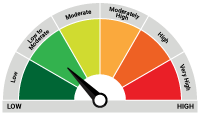Debt monthly view for May 2022
Posted On Thursday, Jun 09, 2022
The MPC (Monetary Policy Committee) of the RBI raised the policy repo rate by 50 basis points from 4.40% to 4.90%. Consequently, the standing deposit facility (SDF) rate stands adjusted to 4.65%, and the marginal standing facility (MSF) rate, and the Bank Rate to 5.15%.
The MPC also dropped the phrase “staying accommodative” from its forward guidance and guided it to “remain focused on withdrawal of accommodation to ensure that inflation remains within the target going forward, while supporting growth”.
Consumer price inflation has been running above the RBI’s upper threshold of 6% since the start of this year averaging at 6.72% between January-April 2022. RBI’s own estimate of average inflation in the fiscal year 2022-23 has been revised higher from 5.7% to 6.7%.
The RBI is now squarely focused on bringing down inflation. The MPC statement noted - “Continuing shocks to food inflation could sustain pressures on headline inflation. Persisting inflationary pressures could set in motion second round effects on headline CPI. Hence, there is a need for calibrated monetary policy action to keep inflation expectations anchored and restrain the broadening of price pressures.”
Taking into account the introduction of the SDF in the April monetary policy at rate of 25 basis points below the repo rate, the RBI has raised the effective overnight interest rate by 130 basis points over the last two months. The floor policy rate before the April monetary policy was at 3.35% (the reverse repo rate). It has now moved to the SDF rate of 4.65%.
This clearly shows a sense of urgency within the RBI to withdraw the ultra-easy monetary policy.
Given the fact that the policy repo rate is still significantly lower than the expected inflation rate, the RBI may continue with the rate hikes in the remaining MPC meetings in 2022. However, the pace of rate hikes (quantum of hike in each policy) may slow down after the covid time the ultra-accommodative monetary policy is reversed.
Before the Covid shock, the Repo rate was at 5.15%. With another 25-50 basis points hike in the August meeting, the repo rate will get to the pre-covid level. Overall, we expect the repo rate to peak around 6% by early 2023.
On liquidity, the RBI reiterated to normalise the pandemic-related extraordinary liquidity surplus over a multi-year time frame though it kept the CRR (Cash Reserve Ratio) rate unchanged in this policy.
The bond market was already pricing for a 40-50 basis points rate hike in this policy. So, the policy outcome was broadly in line with the market expectation.
However, after the surprise repo rate and CRR hike on May 4, 2022, the market had built in some premium for another CRR hike and/or an outsized repo rate hike in this policy. To that extent, there was a positive surprise for the bond market. Bond yield came down 3-9 basis points after the policy announcement. The 5-year government yield came down from 7.36% to 7.28% during the day.
Much of the potential rate hikes are already priced in the current bond valuations. The yield spread between the 3-year bond (6.94%) over the 3 months treasury bill (4.98%) is around 196 basis points vs its long term 20 year average of around 70 basis points.
Thus, the bond market may not be too sensitive to RBI’s rate hikes going forward. However, high uncertainty over global monetary policy, rising crude oil prices, and unfavourable demand-supply dynamics will continue to put upward pressure on medium to long-term bond yields.
Lending rates have already moved up as most loans today are linked to benchmarks like Repo rate or MCLR. We should expect further upward revision in lending rates. The interest rate on fixed deposits will also move higher in the coming months.
From an investor's perspective, the return potential of liquid and debt funds has improved significantly after the sharp jump in bond yields over the last six months. The gap between the bank savings rates and liquid fund returns will widen and remain attractive for your surplus funds. Investors with a short holding period and low-risk appetite should stick to categories like liquid funds of good credit quality portfolios.
Medium to Long term interest rates in the bond markets are already at long-term averages as compared to fixed deposits which remain low. Investors with more than 2-3 years holding period can consider dynamic bond funds which have the flexibility to change the portfolio positioning as per the evolving market conditions. However, such investors should be ready to tolerate some intermittent volatility in the portfolio value.
In the Quantum Dynamic Bond Fund, we have been avoiding long-term bonds for some time due to our cautious stance on the markets. After the steep sell-off in the last two months, valuations have become attractive on medium to long-term bonds. However, given the high uncertainty as mentioned above, we will continue to be cautious in adding into long-duration bonds as a core portfolio position.
We continue to like the 3-5 year segment of the bond market, the bulk of the QDBF portfolio is in 3-4 year maturity government bonds.
We would remain open and nimble to exploit any market mispricing by making a measured tactical allocation to any part of the bond yield curve as and when the opportunity arises.
We stand vigilant to react and change the portfolio positioning in case our view on the market changes.
Source: Worldometer.info
| Name of the Scheme | This product is suitable for investors who are seeking* | Riskometer |
| Quantum Dynamic Bond Fund An Open-ended Dynamic Debt Scheme Investing Across Duration. A relatively high interest rate risk and relatively low credit risk. | • Regular income over short to medium term and capital appreciation • Investment in Debt / Money Market Instruments / Government Securities |  Investors understand that their principal will be at Low to Moderate Risk |
The Risk Level of the Scheme in the Risk O Meter is based on the portfolio of the scheme as on May 31, 2022.
| Potential Risk Class Matrix – Quantum Dynamic Bond Fund | |||
| Credit Risk → | Relatively Low | Moderate (Class B) | Relatively High (Class C) |
| Interest Rate Risk↓ | |||
| Relatively Low (Class I) | |||
| Moderate (Class II) | |||
| Relatively High (Class III) | A-III | ||
Disclaimer, Statutory Details & Risk Factors:
The views expressed here in this article / video are for general information and reading purpose only and do not constitute any guidelines and recommendations on any course of action to be followed by the reader. Quantum AMC / Quantum Mutual Fund is not guaranteeing / offering / communicating any indicative yield on investments made in the scheme(s). The views are not meant to serve as a professional guide / investment advice / intended to be an offer or solicitation for the purchase or sale of any financial product or instrument or mutual fund units for the reader. The article has been prepared on the basis of publicly available information, internally developed data and other sources believed to be reliable. Whilst no action has been solicited based upon the information provided herein, due care has been taken to ensure that the facts are accurate and views given are fair and reasonable as on date. Readers of this article should rely on information/data arising out of their own investigations and advised to seek independent professional advice and arrive at an informed decision before making any investments.
Mutual fund investments are subject to market risks read all scheme related documents carefully.
Please visit – www.quantumamc.com/disclaimer to read scheme specific risk factors. Investors in the Scheme(s) are not being offered a guaranteed or assured rate of return and there can be no assurance that the schemes objective will be achieved and the NAV of the scheme(s) may go up and down depending upon the factors and forces affecting securities market. Investment in mutual fund units involves investment risk such as trading volumes, settlement risk, liquidity risk, default risk including possible loss of capital. Past performance of the sponsor / AMC / Mutual Fund does not indicate the future performance of the Scheme(s). Statutory Details: Quantum Mutual Fund (the Fund) has been constituted as a Trust under the Indian Trusts Act, 1882. Sponsor: Quantum Advisors Private Limited. (liability of Sponsor limited to Rs. 1,00,000/-) Trustee: Quantum Trustee Company Private Limited. Investment Manager: Quantum Asset Management Company Private Limited. The Sponsor, Trustee and Investment Manager are incorporated under the Companies Act, 1956.
Related Posts
-

Debt Monthly for December 2025
Posted On Tuesday, Dec 02, 2025
As we approach the end of the calendar year, we find ourselves at a pivotal moment, with the market split on the likelihood of an upcoming rate cut.
Read More -

Debt Monthly for November 2025
Posted On Tuesday, Nov 04, 2025
October 2025 in a Nutshell: Monetary Policy and Demand–Supply
Read More -

Debt Monthly for October 2025
Posted On Friday, Oct 03, 2025
September was a pivotal month for fixed income markets, both globally and domestically.
Read More



